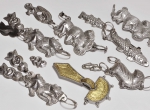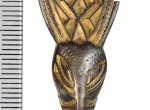Goths
Goths, an East Germanic people of Scandinavian origin. The earliest references to the G. are in Strabo and Tacitus, by whom they area placed, before 18/19 AD, on the southern coast of the Baltic. According to Ptolemy the G. were found to the east of the Vistula River. The crucial source on the history of the G. is Getica of →Jordanes , an extract from an earlier work by →Cassiodorus which he wrote at the behest of King Theodoric the Great to record the history of the G. In Getica there is a legend about three ships on which, led by Berig, their king, the G. came across the sea to a place known as Gothiscandza, identified with the region at the mouth of the Vistula River. From this area, under Filimer, fifth king after Berig, they set off to the south-east, to the Black Sea (Pontus) crossing a great marsh and reaching the fertile land of Oium. The marsh is identified with Polesia, and Oium would be the steppes of southern Ukraine. On the Black Sea the G. arrived before 238 AD (perhaps, even earlier during the 3rd century) and began attacking the Roman cities there; the first to be plundered was Olbia on the estuary of the Southern Bug River, and soon after, Histria, on the mouth of the Danube. On their pirate ships the G. made excursions on the Greek islands and Peloponnese. In 251 in the Battle of Abrittus (Razgrad in Dobruja) they slew Emperor Decius. The G. were defeated sometime later by emperors Claudius (269) and Aurelian (271).
G. have been identified with →Wielbark Culture (named after a prehistoric cemetery at Malbork-Wielbark) which developed on the Lower Vistula during the first half of the 1st century AD and later spread across the region to the west of the Vistula River in the lake districts of the region (Pojezierze Kaszubskie, Pojezierze Krajeńskie) all the way to the Tuchola Forest and northern reaches of Greater Poland. East of the Vistula River Wielbark Culture took in the lake district of Iława (Pojezierze Iławskie) and reached the Parsęta River and the area near today’s Olsztyn. Starting from late 2nd century finds of Wielbark Culture shift to the south-east, to the part of Mazowsze east of the Vistula River, Podlahia, Polesia, Volhyn and Podolia. In the Hrubieszów Basin a new, distinctive Masłomęcz Group takes form. During the same period the cemeteries of Wielbark Culture in eastern Pomerania fall out of use. These changes in settlement nicely correspond to the migration of the G. known from the written sources.
Starting from the first half of the 3rd century, across much of Ukraine, to the south of Kiev all the way to the Black Sea, between the Western Bug and the Desna and the Donets rivers, Cherniakhiv Culture takes form (named after a cemetery discovered at Cherniakhiv), its decline synchronised with the invasion of →Huns in 375.
Around 290 on the Black Sea the G. split into →Ostrogoths and →Visigoths .
MM
Literature: V. Bierbrauer, Die ostgotischen Grab- und Schatzfunde in Italien, Spoleto 1975; J. Strzelczyk, Goci – rzeczywistość i legenda, Warszawa 1984; R. Wołągiewicz, Die Goten im Bereich der Wielbark-Kultur [in:] Peregrinatio Gothica, Archaeologia Baltica 84/85, Łódź 1986, p. 63-98; M. Kazanski, La diffusion de la mode danubienne en Gaule (fin du IVe siècle - début du VIe siècle): essai d’interprétation historique, Antiquités Nationales 21, 1989, p. 59-73; P. Périn (ed.), Gallo-Romains, Wisigoths et Francs en Aquitanie, Septimanie et Espagne, Actes des VIIe Journées internationales d’Archéologie mérovingienne Toulouse 1985, Rożen 1991; V. Bierbrauer, Archäologie und Geschichte der Goten vom 1.-7. Jahrhundert. Versuch einer Bilanz, Frühmittelalterliche Studien 28, 1994, p. 51-171; V. Bierbrauer, Das Frauengrab von Castelbolognese in der Romagna (Italien). Zur chronologischen, ethnischen und historischen Auswertbarkeit des ostgermanischen Fundstoffs des 5. Jahrhunderts in Südosteuropa und Italien, Jahrbuch des Römisch-Germanischen Zentralmuseums Mainz 38, 1995, p. 541-592; A. Kokowski, Schätze der Ostgoten, Stuttgart 1995; V. Bierbrauer, Les Wisigoths dans le royaume franc [in:] F. Vallet, M. Kazanski, P. Périn, (eds.), Des royaumes barbares au Regnum Francorum. L’Occident à l’époque de Childéric et de Clovis (vers 450 – vers 530). Actes de XVIIIes Journées Internationales d’Archéologie Mérovingienne, Bulletin des Antiquités nationales 29, 1997, p. 169-200; J. Tejral, Neue Aspekte der frühvölkerwanderungszeitlichen Chronologie im Mitteldonauraum [in:] J. Tejral, H. Friesinger, M. Kazanski, (eds.), Neue Beiträge zur Erforschung der Spätantike im mittleren Donauraum, Spisy Arheologického Ústavu AV ČR Brno 8, Brno 1997, p. 321-392; A. I. Ajbabin, Etničeskaja istorija rannebizantijskogo Kryma, Simferopol 1999; W. Ebel-Zepezauer, Studien zur Archäologie der Westgoten vom 5.-7. Jh. n. Chr, Iberia Archaeologica 2, Mainz am Rhein 2000; H. Wolfram, Die Goten. Von den Anfängen bis zur Mitte des sechsten Jahrhunderts, München 2001; H. Wolfram, Historia Gotów, Warszawa-Gdańsk 2003; M. B. Ščukin, Gotskij put’. Goty, Krym i černjachovskaja kul’tura, Sankt-Peterburg 2005; J. Kolendo, Plemiona Pomorza w starożytności [in:] Nowakowski, W. et all. (eds.), Goci i ich sąsiedzi na Pomorzu, Koszalin, 2006, p. 17-33; M. Ščukin, M. Kazanski, O. Sharov, Des les goths aux huns: Le nord de la Mer Noire aus Bas-empire et à l’époque des grandes migrations, BAR International Series 1535, Oxford 2006; V. Bierbrauer, Neue ostgermanische Grabfude des 5. und 6. Jahrhunderts in Italien, Acta Praehistorica et Archaeologica 39. Festschrift W. Menghin, 2007, p. 93-124; A. Kokowski, Goci. Od Skandzy do Campi Gothorum (od Skandynawii do Półwyspu Iberyjskiego), Warszawa 2007; M. Mączyńska, Światło z popiołu. Wędrwówki ludów w Europie w IV i V w., Warszawa 2013, esp. p. 52-71.
-
 pełna rozdzielczość
pełna rozdzielczość
Fig. 1. Silver anthropo- and zoomorphic ornaments and the silver gilt brooch from the deposit found in Nowe Marzy, Świecie District, 1st half of the 5th c.; unpublished; (phot. by M. Rudnicki)
-
 pełna rozdzielczość
pełna rozdzielczość
Fig. 2. Terminal of the silver gilt brooch in animal style found at the Gopło lake, Mogilno District, 6th c.; unpublished; (phot. by M. Rudnicki)


